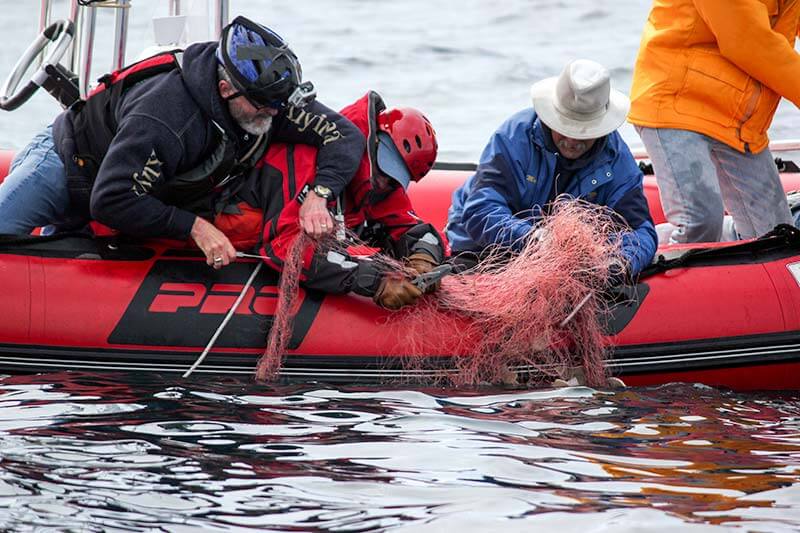Whale Entanglement Part 2: How Entangled Whales Are Rescued

With over 300,000 marine mammals, including large whales, dolphins, and porpoises, dying every year from fishing gear entanglement, this worldwide devastating phenomenon is catching the attention of people around the globe.
While our oceans are both vast and incredible, what takes place below the surface with fishing gear, line, and traps is alarming. Even more saddening is a large number of physical effects of entanglement on a whale. As the number of entangled whales increases, the National Oceanic and Atmospheric Administration’s National Marine Fisheries Service continues to conduct thorough research to better discover how both active and derelict fishing gear, as well as lines, ropes, and chains, drastically and negatively affect the physical well being of whales.
How Entanglement Occurs
Whale entanglement occurs in many different ways, and the debris and material often cause life-threatening harm to one or many different areas of the animal. Because many fishing lines and nets stretch over large areas and reach all the way down to the ocean floor, it can be quite difficult for a large whale to avoid.
In addition, these friendly and gentle giants are naturally curious when it comes to their surroundings, causing them to dwell in close proximity to the gear which results in entanglement. This also occurs when large whales are lunge feeding in areas where gear, lines, and ropes are present.
How Entanglement Harms a Whale
Whales will lunge feed to collect food, and in the process, catch the rope across their mouth which will become lodged towards the back of their jaw behind their baleen plates. At times, lodged so tightly that it will cause great pain due to being up so close to the tissue of the whale, and at times, down to the bone from great wearing. These lines can be wrapped around the whale’s mouth, restricting its ability to open it, thus leading to its inability to eat and causing starvation.
Other locations on the body include the fins, flippers, and tail which will catch the fishing gear such as gill nets and Dungeness crab traps. In an effort to shed the gear and or because of their great size and quick reaction to the entanglement, the whale will become more entangled.
Whales spotted with gear attached, such as entangled humpback whales or entangled gray whales, have been found dragging the gear for days and sometimes months, resulting in extreme exhaustion and the inability to feed, swim, and reproduce, ultimately leading to death.
Because of their remarkable size, demeanor, and inability to free themselves from the debris, these whales experience an array of physical damages, restrictions, and pains. Other smaller sea creatures will often die instantaneously due to drowning. But because of the large size of the whales, they are not in dire risk of drowning and are able to survive longer while entangled with materials resulting in fewer dead whales. This does not eliminate the discomfort that the debris causes.
Although a number of whales have been able to free themselves from entanglement, scientists have discovered a variety of whales show scarring on various parts of their bodies from prior entanglements not discovered at the time. Proving that there are more whales being entangled in the oceans then what is currently recorded.

Entangled Whale Rescue Efforts
In an effort to assist and bring relief to the whale population, a number of trained and qualified members of rescue and response teams, often referred to as a large whale entanglement response network, spend countless hours striving to attain the appropriate training to disentangle whales.
Because whales are wild, they can be unpredictable, especially under stress when entangled, deeming disentanglement efforts extremely dangerous. Each disentanglement team is required to gain extensive training consisting of many hours of study and instruction. Stranding network biologists and partners are called upon for an entanglement response which involves an intricate process to disentangle the wildlife.
Since large whales are typically not at risk for immediate death when entangled, it often gives responders the necessary time to cut the whale free. Although there is time, it does not eliminate the risks and dangers involved with disentangling a massive, 40-60 ton, free-roaming animal that is under a great deal of stress.
In order to assist the animal in the best manner possible, rescue teams have adopted and modified a procedure called “kegging”. The method was implemented in the days of whaling and involves attaching barrels or kegs to whales, enabling the whale to tire out and stay at the surface. (Instead of barrels, rescuers now use buoys.)
Once the whale is at an appropriate distance, rescuers will use specially designed knives and hooks at the end of large poles to reach the whale and safely cut the entanglements without hurting the animal. Intricate and specialized movements are used during the process while rescuers are aboard vessels such as small inflatable boats that will get them close to the animal. These procedures will go on for hours on end, and in some cases, the whales need to be tracked for days.
NOAA Fisheries on the U.S. west coast is currently implementing a tool referred to as telemetry, which involves using transmitters and receivers to track the entangled wildlife for extended periods of time. This is a paramount tool in whale rescue.
Captain Dave founded Orange County’s first whale disentanglement group. He and other NOAA-trained disentanglement team members have been involved with multiple disentanglement efforts, including entangled gray whale “Lily” and entangled gray whale “Bart”. Captain Dave was also involved with the first disentanglement effort of a blue whale, that largest animal on earth.
Rescuing Whales Can Be Dangerous Work
As stated above, disentanglement efforts are extremely dangerous and pose a large number of threats to rescuers. In fact, in 2017, Joe Howlett, volunteer, whale rescuer, and co-founder of the Campobello Whale Rescue Team in northeastern New Brunswick, received a ‘catastrophic’ blow from a whale’s tail shortly after spending five hours to disentangle it. As Howlett cut the last bit of entanglement on the whale, the animal plunged down into the water and flipped its tail into the bow of the boat where Howlett was standing. It is stated that “the tail struck Howlett with roughly a tonne of force.”
The onlooker and loved ones took comfort in knowing that Joe Howlett passed away doing something he loved. “He was really happy at his very last moment. I take some comfort in that,” said Phillip Hamilton, a research scientist at the New England Aquarium’s Anderson Cabot Center for Ocean Life.
Other risks involve the sharp tools used to cut the ropes and gear around whales, which can present serious dangers for responders, especially if they are pulled overboard during the process.
Although wild animals’ behaviors and the disentanglement tools present great risks, the techniques and procedures that have evolved and developed over the past 40 years allow rescue teams to respond in the safest way possible. This does not eliminate all dangers, and injuries and death have taken place. This is why it is especially important that the properly trained individuals with an MMHSRP permit participate in whale disentanglement, while untrained professionals leave it to the pros.
What To Do If I See an Entangled Whale
We understand that in an effort to help these incredible creatures, many who are untrained will willingly step in to assist. Their intentions are appreciated, but the best way for citizens to help would begin with promptly reporting the entanglement. In California, Oregon, or Washington call the Entanglement Reporting Hotline at 1-877-SOS-WHALe (1-877-767-9425) or contact the U.S. Coast Guard on a VHF radio, channel 16. Authorities can then assemble the appropriate professionals to respond to the disentanglement.
Note the location of the whale, the species (if known), the nature of the entanglement (what kinds of lines or buoys do you see), the condition of the whale, and if the animal is moving, what speed and direction it’s headed.
After contacting the authorities, try to stay with the whale if possible but DO NOT approach. Keep yourself at a safe and respectful distance from the whale. Try to take as many pictures and videos of the whale’s entanglement as possible to share with disentanglement teams. By doing so, they can be better prepared and it will help disentanglement efforts in the future. Additionally, always remember that safety comes first and never attempt disentanglement efforts on your own.
As a greater effort is made to assist in the disentanglement of many of our earth’s magnificent creatures, many are beginning to realize how important it is for each of us to do our part in helping these animals.
Join us in part three where we will take a greater in-depth look at how these entanglements can be prevented, and what we can do as a society to aid in these extraordinary efforts.
